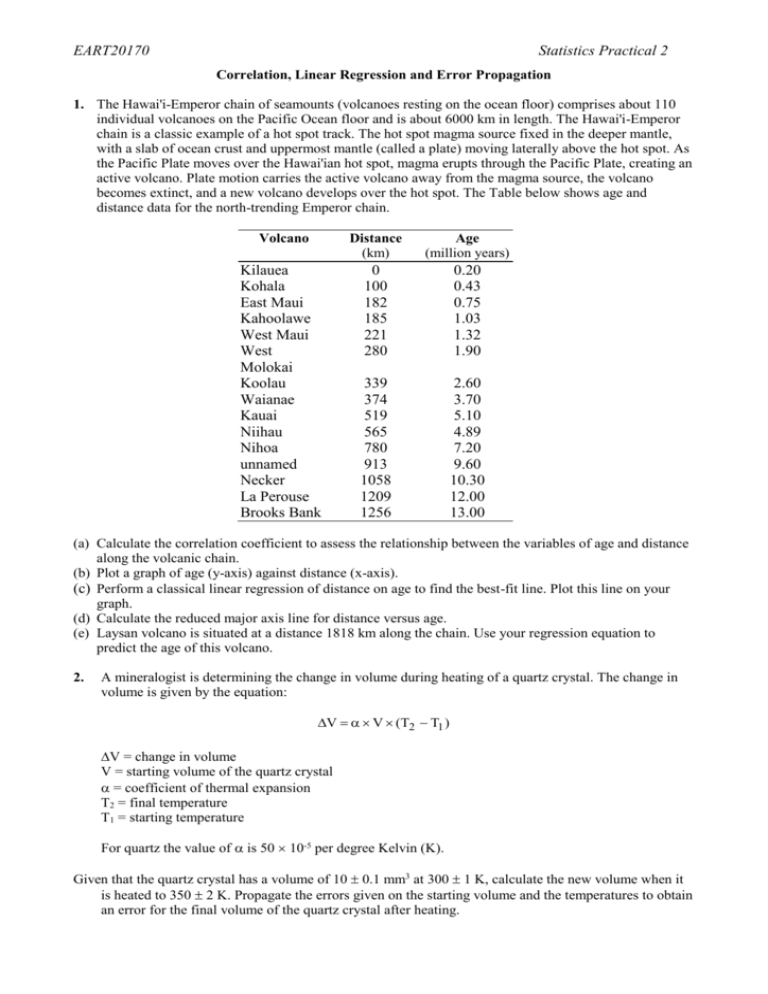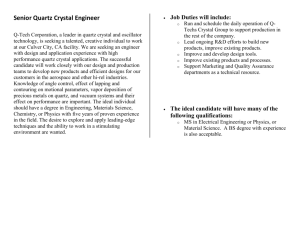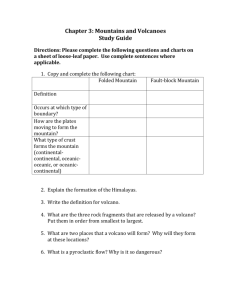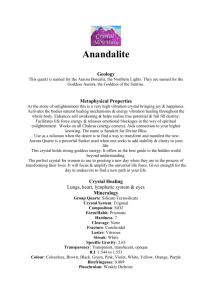Stats Practical 2 2006
advertisement

EART20170 Statistics Practical 2 Correlation, Linear Regression and Error Propagation 1. The Hawai'i-Emperor chain of seamounts (volcanoes resting on the ocean floor) comprises about 110 individual volcanoes on the Pacific Ocean floor and is about 6000 km in length. The Hawai'i-Emperor chain is a classic example of a hot spot track. The hot spot magma source fixed in the deeper mantle, with a slab of ocean crust and uppermost mantle (called a plate) moving laterally above the hot spot. As the Pacific Plate moves over the Hawai'ian hot spot, magma erupts through the Pacific Plate, creating an active volcano. Plate motion carries the active volcano away from the magma source, the volcano becomes extinct, and a new volcano develops over the hot spot. The Table below shows age and distance data for the north-trending Emperor chain. Volcano Distance (km) Age (million years) Kilauea Kohala East Maui Kahoolawe West Maui West Molokai Koolau Waianae Kauai Niihau Nihoa unnamed Necker La Perouse Brooks Bank 0 100 182 185 221 280 0.20 0.43 0.75 1.03 1.32 1.90 339 374 519 565 780 913 1058 1209 1256 2.60 3.70 5.10 4.89 7.20 9.60 10.30 12.00 13.00 (a) Calculate the correlation coefficient to assess the relationship between the variables of age and distance along the volcanic chain. (b) Plot a graph of age (y-axis) against distance (x-axis). (c) Perform a classical linear regression of distance on age to find the best-fit line. Plot this line on your graph. (d) Calculate the reduced major axis line for distance versus age. (e) Laysan volcano is situated at a distance 1818 km along the chain. Use your regression equation to predict the age of this volcano. 2. A mineralogist is determining the change in volume during heating of a quartz crystal. The change in volume is given by the equation: V V (T2 T1 ) V = change in volume V = starting volume of the quartz crystal = coefficient of thermal expansion T2 = final temperature T1 = starting temperature For quartz the value of is 50 10-5 per degree Kelvin (K). Given that the quartz crystal has a volume of 10 0.1 mm3 at 300 1 K, calculate the new volume when it is heated to 350 2 K. Propagate the errors given on the starting volume and the temperatures to obtain an error for the final volume of the quartz crystal after heating. EART20170 3. Statistics Practical 2 (a) Find the best combined result and error for the radius of the Earth, R (in metres) from the following data: 6379020 11294 6377940 15432 6376645 18949 6378004 9900 (b) The density (D) of a spherical body is related to its mass (M) and radius (R) by the relationship: D 3 M 4 R3 Assuming a spherical shape with = 3.142, M = 5.977 1024 Kg calculate the average density for the Earth (in Kg m-3). (c) Derive an error propagation formula for D assuming that R and M both have errors. (d) Combine the error in R obtained in part (a), with an error in M = 0.005 1024 Kg, to calculate a final error in D. EART20170 Statistics Practical 2 Statistics Practical 2: Answers 1 (a) Calculation of r2 Distance (x) Age (y) 0 0.20 100 0.43 182 0.75 185 1.03 221 1.32 280 1.90 339 2.60 374 3.70 519 5.10 565 4.89 780 7.20 913 9.60 1058 10.30 1209 12.00 1256 13.00 7981 74.02 r r r xy 2 x 2 x N x2 y2 xy 0 0.04 0 10000 0.1849 43 33124 0.5625 136.5 34225 1.0609 190.55 48841 1.7424 291.72 78400 3.61 532 114921 6.76 881.4 139876 13.69 1383.8 269361 26.01 2646.9 319225 23.9121 2762.85 608400 51.84 5616 833569 92.16 8764.8 1119364 106.09 10897.4 1461681 144 14508 1577536 169 16328 6648523 640.6628 64982.92 xy N 2 y 2 y N 64982 .92 7981 74.02 15 63696361 5479 6648523 640 .7 15 15 25599 .3 0.9952 25721 .9 r 2 0.99 99% (100r2) of the variation in age and distance is explained by their linear relationship; the remaining 1% of the variation is unexplained. (c) Linear regression of distance on age: m 15 64982 .92 7981 74.02 15 6648523 63696361 m 383990 .18 0.0107 36031484 EART20170 Statistics Practical 2 b 74.02 6648523 64982 .92 7981 15 6648523 63696361 b 26505012 0.74 36031484 Equation of the best fit line is: Age 0.0107 Dis tan ce 0.74 Age versus distance for Emperor seamount chain 14 12 Age (Ma) 10 8 6 4 2 0 0 200 400 600 800 1000 -2 Distance (km ) (d) The reduced major axis solution: m 640 .66 5478 .96 15 6648523 63696361 15 m 275 .4 0.000114 0.0107 2402098 .9 y 4.93; x = 532.1 b = y mx b = 4.93-(0.0107 532 .1)= 0.77 (e) The Laysan volcano has a predicted age of 18.7 Ma. 2. The volume of the quartz crystal at 350K is calculated as 1200 1400 EART20170 Statistics Practical 2 V V T2 T1 V 50 10 5 10 (350 300 ) 0.25 mm 3 So new volume V2 after heating is V2 10.25 mm 3 Propagation of errors: First calculate the error in the temperature T2 T21 T22 T 12 2 2 2.23K Now calculate the error in the volume 2 2 T V V V V T2 T1 2 2 V 0.1 2.24 10 50 V 2 2 2 2 0.1 2.24 3 V 0.25 0.011 mm 10 50 V 10.25 0.01 mm 3 3. (a) The values of R can be weighted according to their errors to obtain a weighted average: x s x / s2 1/ s 2 1 1/ s2 0.1596 2.50 10 8 6321 m R = 6378160 6321 m (b) D 3 5.977 10 24 4 3.142 6378160 3 D 5499 Kg m 3 6378160 m EART20170 Statistics Practical 2 (c) 2 2 43R 2 R D 3 M 3 D 3M 4R 2 2 D 3 M R D M R 2 2 (d) 2 0.005 18963 D 5499 5.977 6378160 D 17 Kg m 3 D 5499 17 Kg m 3 2








